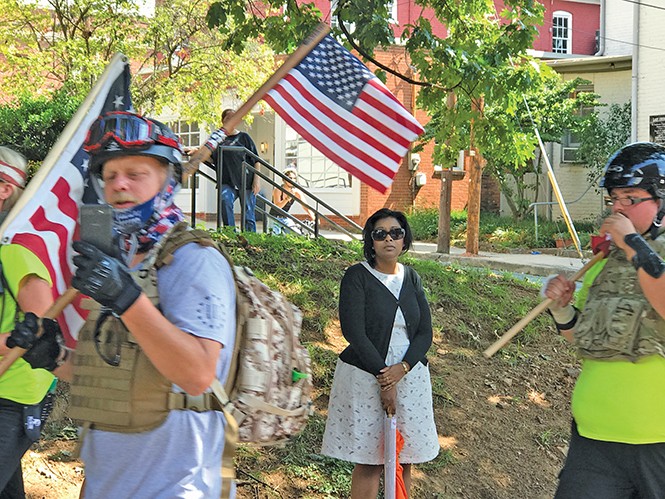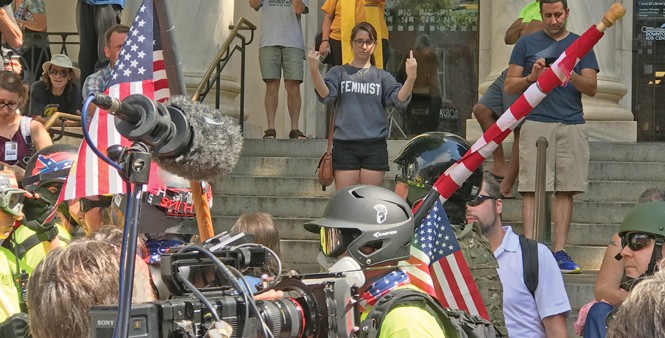Two middle-aged men—one black and one white—are walking up a street in downtown Charlottesville, Va., yelling at each other. It was a moment of relative normalcy in a day otherwise defined by mayhem.
Both men use the phrase "born and bred" to define their relationship to the smallish Southern college town, nestled in the hills of the politically contested state.
The white man, Ed Knight, wears a Confederate flag-emblazoned bandana around his head.
"You, with that stupid Confederate flag, talking about history," says the black man, George Steppe. "You don't know nothing about no history. Only thing you know is hate."
"This is our history and it should not be destroyed," Knight replies, referring to the statue of Robert E. Lee in Emancipation Park, where Unite the Right, a far-right rally was scheduled.
Knight supported the rally that attracted a horde of armed demonstrators to his home city on Saturday, Aug. 12. It also brought hundreds of anti-fascists—some of them armed with sticks and shields—pledging to defend the city from right-wing terror. Now, after hours of bloody battle during which they remained largely passive, riot police were breaking the melee up, pushing Steppe back, inching forward behind their shields. Knight walked alongside with a sign reading, "Make C-Ville Great Again."
The chaos started the night before, as Nazis and other racists gathered for the 21st-century version of a Klan rally—a Klanclave of khaki and tiki torches. At one point, a group of the white supremacists surrounded a group of counter protesters, throwing punches and torches.
The scene started to brew earlier that morning.
White supremacists in helmets—some German World War II-era—white polos, sticks, an assortment of flags and homemade shields with the insignia of the racist group Vanguard America chanted at a smaller crowd of counter protesters.
"You can't run, you can't hide, you get helicopter rides," they said, a reference to far-right governments in Argentina and Chile in the '70s and '80s that threw leftists from helicopters to "disappear" them.
As they began to march forward, anti-racists attempted to block them. After a swirl of violence and swinging sticks, three of the counter protesters were left with bloody faces. The racists—who also took some heavy blows—seemed to target women's faces with their sticks. They ran away as the cops finally rolled in and began setting up a barricade.
Over the next several hours, this same pattern continued to play out: Another fight broke out every few minutes as a new faction of the right marched in its crazed Tom Sawyer armor toward the park.
The space was filled with every variety of racist you can imagine, from the Nazi biker to the fashy computer programmer. They were almost exclusively white and male. The anti-fascist activists who packed the streets were also predominantly white, but there were far more women and people of color opposing the Nazis. Otherwise, the two opposing armies seemed to be of roughly equal size. The fights were swift, chaotic and brutal.
The two sides launched bottles and tear-gas canisters back and forth as state troopers, slack-jawed, stood and watched. At one point, as a few bottles whizzed by him in quick succession, a trooper perked up enough to pull out his phone and record some of the mayhem.
When the police declared the assembly illegal before it even began and told everyone to leave, it forced these groups together. Right-wing militia types wielding assault rifles and wearing MAGA patches on paramilitary uniforms roamed through the crowd. Guys armed with pistols seemed to keep their hands on them, ready to draw at any moment. It felt like something horrible was about to happen.
Then, as the various groups became separated, it seemed like the rumble had largely ended.
"I'm glad no serious gunshots rang out. I was threatened with a gun, though. Police wasn't around when a guy pulled up his gun up on me, though," Steppe said around 12:30 p.m.
Steppe and Knight both seemed to think that it was the end of the day.
The racists, who had not been able to hold their rally, were trying to regroup at another neighboring downtown park. Eventually, as a state of emergency was declared, they decided to leave—some of them even suggested hiding in the woods.
Antifa burned right-wing flags in a park and then marched through the city; two groups converged on Water Street at around 1:35 p.m. It felt triumphant. They had driven the racists out of town—or at least those from out of town.
Five minutes later, as they marched through the streets, it sounded like a bomb exploded: A muscle car, which police say was driven by 20-year-old far-right member James Alex Fields, sped down the street and plowed through the march and into other cars. Fields then threw the weaponized car into reverse, fleeing from the scene of terror.
Bodies were strewn through the road. Street medics delivered first aid while waiting on ambulances to arrive. Activists held Antifa banners to block camera views of the injured.
The far-righters were nowhere to be found. Trump meandered through a speech in New Jersey in which which he condemned violence on "many sides."
He did not use the words white supremacy or terrorism. He did not mention the name of Heather Heyer, the woman who was killed in the terror attack. He did not offer support to the 19 others who were hospitalized or "thoughts and prayers" for those who were still in critical condition.
Fields, who was photographed earlier in the day with the same Vanguard America shield I saw when I first arrived in town, was arrested and charged with suspicion of second-degree murder.
I am writing this later the same night as the attack and I won't to pretend to know what it means for our country. Racism is not new. The argument Steppe and Knight were having in their hometown could have happened any time in the last 50 years. But the way the battle over white supremacy was being waged around them was new, and Charlottesville was not ready for it. None of us were.
When Fields' Dodge Challenger slammed into those people, it shattered a part of America, or at least the illusion of it. I don't know what that means yet, because it shattered something in me, too.
Additional reporting by Brandon Soderberg
More by Baynard Woods
-
Final Democracy
Democracy in Crisis project comes to an end.
- Jul 4, 2018
-
One Man's Drug Checks Help Save Lives
With an inept drug czar and vindictive DOJ, citizens are left to address opioid crisis on their own.
- Jan 31, 2018
-
Conspiracy Theories
Government's case sets low bar for conspiracy charges on eve of J20 trial.
- Nov 15, 2017
- More »
Latest in News
Readers also liked…
-
Raise a glass for E.L.T Harrison, architect of the Beerhive building on Main
Small Lake City
- Oct 11, 2023





